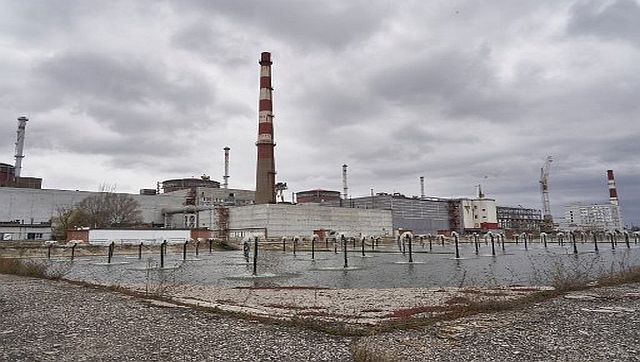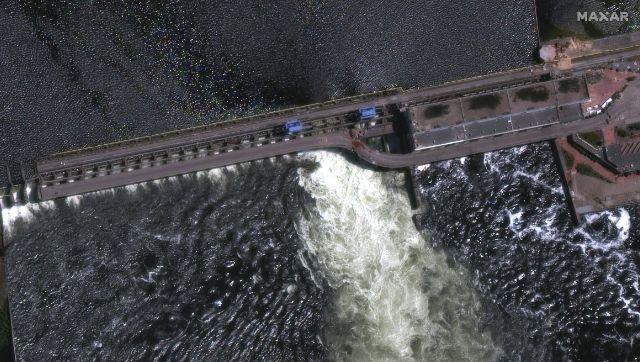A major dam in southern Ukraine has crumbled – raising fears of a nuclear disaster, causing floods and threatening the water supply. Ukraine has accused Russian forces of blowing up the 3.3-kilometre dam Kakhovka dam captured at the beginning of the war. However, Moscow in turn has blamed Kyiv for bombing the area. Let’s take a look at the dam and how it could affect both sides: People at risk, water supply in peril According to The Guardian, the Kakhovka dam was constructed in 1956 as part of the Kakhovka hydroelectric power plant.
The dam spanning the Dnipro River is hundreds of metres wide and 30 metres tall.
The Kakhovka reservoir, which is upstream from the dam, can hold 18 cubic kilometres of water – approximately the same capacity as Utah’s Great Salt Lake. According to the BBC, the reservoir supplies water to many communities upstream including farmers. The dam pumps water into the North Crimean Canal, which starts in southern Ukraine and crosses the entire Crimean peninsula. This means that any problem with the dam could cause water supply problems for Crimea, which has been under Russian control since 2014. Ukraine controls five of the six dams along the Dnieper, which runs from its northern border with Belarus down to the Black Sea and is crucial for the country’s drinking water and power supply. [caption id=“attachment_12700822” align=“alignnone” width=“640”] A resident in Kherson gestures near his house which was flooded. Russian troops have been accused of blowing up the Kakhovka dam overnight. AP[/caption] About 22,000 people live in areas at risk of flooding in Russian-controlled areas, while 16,000 live in the most critical zone in Ukrainian-held territory, according to official tallies. The World Data Center for Geoinformatics and Sustainable Development, a Ukrainian nongovernmental organization, estimated that nearly 100 villages and towns would be flooded. It also reckoned that the water level would start dropping only after five-seven days. Ukrainian authorities have previously warned that the dam’s failure could unleash 18 million cubic meters (4.8 billion gallons) of water and flood Kherson and dozens of other areas where thousands of people live. Andriy Yermak, the head of Ukraine’s President’s Office, posted a video showing swans swimming near an administrative building in the flooded streets of Russian-occupied Nova Kakhovka, a city in the Kherson region where some 45,000 people lived before the war. Other footage he posted showed flood waters reaching the second floor of the building. Ukraine’s Interior Ministry urged residents of 10 villages on the Dnieper’s right bank and parts of the city of Kherson downriver to gather essential documents and pets, turn off appliances, and leave, while cautioning against possible disinformation. CNN quoted the Russian-installed mayor of occupied Nova Kakhovka, Vladimir Leontyev as saying that the city is flooded. Ukraine, which now controls the river’s right bank, said on Tuesday there was flooding in at least eight areas along the Dnipro River. About 16,000 people are in a critical flood zone, according to Ukrainian officials. Risk of nuclear disaster Then there is the risk of a nuclear disaster to the nearby Zaporizhzhia power plant. [caption id=“attachment_12439752” align=“alignnone” width=“640”]
 A general view of the Russian-controlled Zaporizhzhia nuclear power plant in southern Ukraine. AFP[/caption] While the United Nations and Russia said there was no major risk to the nuclear power plant, Ukraine has claimed there is a growing danger. Ukraine’s nuclear operator Energoatom said in a Telegram statement that the damage to the dam “could have negative consequences” for the Zaporizhzhia Nuclear Power Plant, which is Europe’s biggest, but wrote that for now the situation is “controllable.” The UN’s International Atomic Energy Agency said in a statement there was “no immediate risk to the safety of the plant,” which requires water for its cooling system. It said that IAEA staff on site have been told the dam level is falling by 5 centimeters (2 inches) an hour. At that rate, the supply from the reservoir should last a few days, it said. The plant also has alternative sources of water, including a large cooling pond than can provide water “for some months,” the statement said. Environment under threat, say experts Both sides warned of a looming environmental disaster. BBC quoted Zelensky’s office as saying the river has already been contaminated with 150 tonnes of industrial lubricants.
A general view of the Russian-controlled Zaporizhzhia nuclear power plant in southern Ukraine. AFP[/caption] While the United Nations and Russia said there was no major risk to the nuclear power plant, Ukraine has claimed there is a growing danger. Ukraine’s nuclear operator Energoatom said in a Telegram statement that the damage to the dam “could have negative consequences” for the Zaporizhzhia Nuclear Power Plant, which is Europe’s biggest, but wrote that for now the situation is “controllable.” The UN’s International Atomic Energy Agency said in a statement there was “no immediate risk to the safety of the plant,” which requires water for its cooling system. It said that IAEA staff on site have been told the dam level is falling by 5 centimeters (2 inches) an hour. At that rate, the supply from the reservoir should last a few days, it said. The plant also has alternative sources of water, including a large cooling pond than can provide water “for some months,” the statement said. Environment under threat, say experts Both sides warned of a looming environmental disaster. BBC quoted Zelensky’s office as saying the river has already been contaminated with 150 tonnes of industrial lubricants.
Another 300 metric tons could still leak out.
“This is ecocide,” Andriy Yermak, the head of the Office of the President of Ukraine was quoted as saying by CNN. “The Russians will be responsible for the possible deprivation of drinking water for people in the south of Kherson region and in Crimea, the possible destruction of some settlements and the biosphere,” he said. The Guardian quoted Ukraine military intelligence as saying that “the scale of the ecological disaster [would] go far beyond the borders of Ukraine and affect the entire Black Sea region”. Mykhailo Podolyak, a senior adviser to President Volodymyr Zelenskyy, said that “a global ecological disaster is playing out now, online, and thousands of animals and ecosystems will be destroyed in the next few hours.” A total collapse in the dam would wash away much of the broad river’s left bank, according to the Ukraine War Environmental Consequences Working Group, an organisation of environmental activists and experts documenting the war’s environmental effects. Halt Ukraine’s ambitions of taking back territory It could also halt Ukraine’s ambitions of taking back territory. The dam is about 60 kilometres east of Kherson, which Ukraine took back in November, turning the river into the new front line. Ukrainian forces were widely seen to be moving forward with a long-anticipated counteroffensive in patches along more than 1,000 kilometers of front line in the east and south.
Flooding could potentially block Ukrainian forces.
Zelensky aide Mykhailo Podolyak told CNN the incident would “create obstacles for the offensive actions of the Ukrainian Armed Forces.” [caption id=“attachment_12700812” align=“alignnone” width=“640”] In this photo provided by the Ukrainian Presidential Press Office, Ukrainian President Volodymyr Zelenskyy, right, chairs the emergency meeting of the National Security and Defense Council on the situation at the Kakhovka HPP after the dam was blown up overnight. AP[/caption] “This once again confirms that the Kremlin is not thinking strategically, but rather in terms of short-term situational advantages. But the consequences are already catastrophic,” Podolyak told CNN. Moscow, Kyiv trade charges Kyiv accused Moscow of mining the dam when combat raged nearby in October, during the last major offensive by Ukrainian forces seeking to regain lost territory. Kremlin proxies in the Kherson region on Tuesday denied any plans to blow up the dam, calling Ukraine’s assertions “lies”. Kyiv says Moscow destroyed the dam to slow down its military counteroffensive.
Russia said the dam was damaged by multiple Ukrainian strikes.
The incident also drew international condemnation, including from German Chancellor Olaf Scholz and NATO Secretary-General Jens Stoltenberg, who said the “outrageous act … demonstrates once again the brutality of Russia’s war in Ukraine.” Not sure which side benefits, say experts It was not immediately clear whether either side benefits from the damage to the dam, since both Russian-controlled and Ukrainian-held lands are at risk. The damage could also hinder Ukraine’s counteroffensive in the south and distract its government, while Russia depends on the dam to supply water to Crimea. Patricia Lewis, director of the International Security Program at Chatham House think tank in London, said apportioning blame is difficult but “there are all sorts of reasons why Russia would do this.” “There were reports (last fall) of Russians having mined the reservoir. The question we should pose is why the Ukrainians would do this to themselves, given this is Ukrainian territory,” she said. Experts have previously said the dam was suffering from disrepair. David Helms, a retired American scientist who has monitored the reservoir since the start of the war, said in an e-mail that it wasn’t clear if the damage was deliberate or simple neglect from Russian forces occupying the facility. But Helms reserved judgement, also noting a Russian history of attacking dams. With inputs from agencies Read all the Latest News , Trending News , Cricket News , Bollywood News , India News and Entertainment News here. Follow us on Facebook, Twitter and Instagram.


)

)
)
)
)
)
)
)
)



